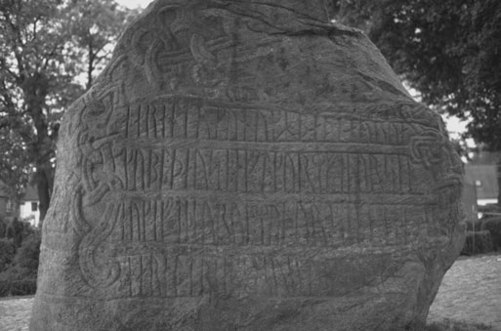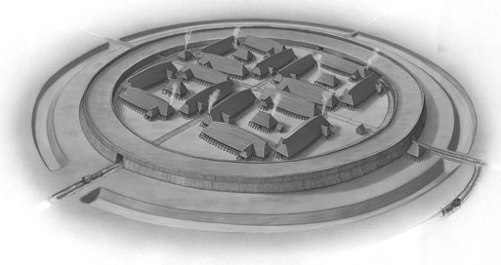The Vikings: A Very Short Introduction (3 page)
Read The Vikings: A Very Short Introduction Online
Authors: Julian D. Richards
Tags: #History, #General, #Social Science, #Archaeology, #Europe, #Medieval

8
The modern Scandinavian countries did not exist at the start of the Viking Age. Whereas the kingdoms of Anglo-Saxon England and Continental Europe had accepted the Christian view of the King as God’s prime servant on earth, this was not the case in Scandinavia.
Scandinavian societies maintained their old structure of tribes, each dominated by a numerous aristocracy, and temporarily ruled by a chieftain.
By the 10th century, Scandinavian warlords who had spent time in Europe returned home and tried to foster new ideas. People were Christianized and royal authority was established. By the 12th century the aristocracy managed to convert power based on old ideologies into new power structures, defined by privileges, documents, and laws. By 1200 each Scandinavian country was established as a nation state according to the Western European
Early Sc
pattern.
an
dina
The Viking Age is therefore seen as the period during which these
vian kin
countries acquired their national identities, and since there is very little written documentation, the dating of archaeological evidence
gdoms
for these early state societies has considerable significance. In recent years a lively debate has waged amongst Scandinavian archaeologists on the subject of the processes that led, during the Scandinavian Iron Age and Viking Age, to state formation. We will examine this evidence, including the increasingly complex hierarchy of rural settlements and the emergence of towns, but first we need some geography.
Denmark took its name from its people, the Danes, although the meaning of the suffix -
mark
is unclear. Today, Denmark comprises the Jutland peninsula, the large islands of Fyn and Sjælland, as well as 500 smaller islands, and the island of Bornholm in the Baltic.
However, during the Viking Age it also included Skåne, Halland, and Blekinge, which were ceded to Sweden in 1658. Its southern frontier lay at the foot of the Jutland peninsula, in what is now north Germany. During the Viking Age much of Denmark was 9
extensively wooded with oak and beech, although there were also sand dunes and heath. Nowhere was more than 55 kilometres from the sea, which provided the basis of livelihood. Cultural innovations reached Jutland first; it is not surprising that it became the main centre of royal power when Denmark emerged as a unified state in the 10th century.
In his
History of the Franks
, Gregory of Tours (538/9–94) reported that in 515 a Danish fleet under a King Chlochillaich invaded Gaul from the sea. It is not known where the Danes referred to came from, or how large an area their king ruled, nor indeed what sort of power he exercised there, although Gregory explicitly uses the term
rex
for the Danish king. Further 6th-century sources mention the
sg
kin
e Vi
Th
10
2
. Viking Age Scandinavia
Danes as a powerful force and Procopius (
c
.500–
c
.565) tells of how the Heruli had to pass through the territory of the Danoi on their way to Scandinavia. But care is required in interpreting such reports; we should not impose either later medieval or Roman concepts of ‘kings’ or ‘peoples’ onto other situations.
Scandinavia was outside the Roman Empire, although Roman influence reached Jutland and is reflected in prestigious diplomatic gifts in Danish Iron Age graves. Such objects were designed to secure frontier zones; they appear to have consolidated the power of local chiefs, empowering them within a gift exchange economy, and maybe establishing power relationships which continued into the Viking Age. The chiefs were not at the pinnacle of the gift exchange for it was their role to officiate over gifts to the gods. The gifts also need to be set against a background of an ideology based upon warfare, in which the spoils of war were given as offerings to the
s
gods in great bog deposits, such as those excavated at Illerup and
g
kin
Ejsbøl in Jutland. Hoards were a particular element in the
e Vi
establishment and legitimation of the elite, which communicated
Th
with the gods on behalf of the community.
In the 7th and 8th centuries there are only scattered references to Danes and their kings in contemporary sources. We know, however, that the missionary Willibrord, bishop of Utrecht, visited King Ongendus, who ruled over ‘the wild tribes of the Danes’, within the period 690–714. Only at the end of the 8th century and particularly in the first half of the 9th century do Frankish Annals provide fuller information on Danish kings, who emerge as worthy opponents of Charlemagne and his successors. We are given the names of a number of kings, including Godfred, and get the impression of a kingdom that already included Skåne and the area around the Oslofjord.
There is archaeological evidence for an organized central power in Jutland in the 8th century. The island of Samsø had strategic importance in the seas to the east of Jutland, and at Kanhave a 12
timber-lined canal, 500 metres long by 11 metres wide, linked the sea to the west of the island with a protected bay to the east. The Kanhave canal would have allowed ships with a draught of up to 1.25 metres to pass from the naval harbour to the west. Tree ring dating shows that the canal was constructed in 726, repaired
c
.750, and could have remained in use until 885.
At the foot of the Jutland peninsula there was the Danevirke, a system of fortifications 14 kilometres long, closing the Schleswig pass between the Schlei fjord which cuts in from the east, and the marshy areas around the rivers which flow into the North Sea on the west. The first ramparts were constructed in 737, and extended under King Godfred in 808. The Danevirke is unlikely to have been purely a mechanism for defence; it was probably as important in controlling the movement of people and animals. It would be a
Early Sc
mistake, however, to take these isolated instances of monumental
an
construction under royal authority as evidence for an 8th-century
dina
state that corresponded to modern Denmark.
vian kin
The name Denmark is first used by Wulfstan, archbishop of York
gdoms
(931–56) and it occurs again later in the 10th century, on the two royal rune stones at Jelling. From the mid-10th century we know of a continuous succession of kings, beginning with Gorm the Old.
Royal power was extended under his son Harald Bluetooth, who conquered Norway in the early 960s; Harold was ousted in 987.
Gorm’s grandson, Svein Forkbeard, and his great-grandson, Cnut, both led armies against England, the latter becoming king in 1016–35. By the late 10th and 11th centuries there was regular Anglo-Danish contact and the exchange of craftsmen between England and Denmark.
13
Harald Bluetooth (d.
c
.987)
Harald Bluetooth was the son of King Gorm, father of Svein
Forkbeard, and grandfather of Cnut. His name – Blåtand in
Old Norse – probably means dark complexion. In an early
rune stone, erected at Jelling, in central Jutland,
c
.960, Harald claims that he unified Denmark and Norway and converted the Danes. There are also two massive burial mounds
at Jelling. Apart from a silver goblet, the northern burials had
been removed, but excavations in Jelling church in the 1970s
located a 10th-century chamber containing a disarticulated
male skeleton. It is now believed that the northern mound
was erected by Harald
c
.959, as a memorial to his parents,
along with the rune stone. After his conversion he had them
sg
removed to the church, and also erected the southern mound,
kin
which became a cenotaph memorial to himself.
e Vi
Th
Harald is credited with several massive public works, which
should be viewed in the context of Danish conflict with the
German Emperor. In 968 he linked the Danevirke to Hedeby
and also extended and rebuilt it with a timber rampart. In
979–80 he built a large bridge over the Vejle river valley
at Ravning Enge. The roadway was 720 metres long and
5.5 metres wide; it was supported by more than 1,500 oak
timbers and must have been intended as a military road.
In the 980s he built a series of circular fortresses at strategic
locations throughout his kingdom – they are named after
the example at Trelleborg in Sjælland, but there are other
examples at Fyrkat in central Jutland, Nonnebakken on
Fyn, and an unfinished one at Aggersborg from the tip of
northern Jutland.
14
Each of the forts was constructed to a regular geometric
blueprint. They had circular ramparts of earth and turf, surrounded by a V-shaped ditch, and covered gateways at all
four compass points. The gates were linked by timber-paved
streets, and by another road inside the rampart. In each
quadrant bow-shaped halls were arranged around a quad-rangle. Only a quarter of the halls were lived in although, at
both Trelleborg and Fyrkat, cemeteries have been found outside the ramparts. The forts must have represented regional
centres for the royal power of Harald Bluetooth, however,
they were only used for around ten years, and only that on
Fyn became a major town. They seem to have been a reckless
Early Sc
expense, each one containing at least 16 fantastic halls with
convex walls, porches, and end rooms, yet were used as
an
storerooms and workshops, and monuments to Bluetooth’s
dina
vanity!
vian kin
gdoms
Norway took its name from the sheltered sea route down its western coast, the
Norvegur
, or ‘North Way’. The coastline is indented by countless fjords; measured in a direct line it is 3000
kilometres, but its real length is 20,000 kilometres. Mountains arise directly from the western coast and the Viking Age population was confined to narrow ledges and small plains at the heads of the fjords, where communities developed in relative isolation, each with its own traditions and culture. More than half the country lies at altitudes above 600 metres, but there are just a few fertile areas of gentle slopes where population is concentrated: Jaeren, in the south-west, Oslofjord, in the south-east, and Trondelag in the north-east. Even today agricultural land accounts for only 3 per cent of the surface area; forests make up 23 per cent and here there was iron, and unlimited supplies of wood, as well as wild animals, including deer, elk, 15


3. Rune stone, Jelling. The inscription reads: ‘King Harald had this
monument made in memory of Gorm, his father, and Thyra, his mother.
That was the Harald who won all of Denmark for himself, and Norway,
sg and made the Danes Christian.’
kin
e Vi
Th
4. Artist’s impression of the fortress at Fyrkat; one of the four
quadrants has not been excavated
wolf, bear, and fox. The northern coastal strip of Halgoland was thinly populated; here the Norse took tribute from the Saami. The sea was a major resource, with whale, seals, and walrus in the far north.
16
Norway was first unified in the 880s by Haraldr Finehair, king of Vestfold which included southern Norway and the coastal districts, but not the far north. Haraldr died
c
.930 and was succeeded by his son, the infamous Erik Bloodaxe (p. 70). Norway shared a border with Sweden and also a short stretch with Denmark but difficulties of land communication meant that the population looked naturally to the sea, and to opportunities in the west. The first recorded Viking raiders in the British Isles were probably from Hordaland, in western Norway, and the Norse were the main Scandinavian colonists in the Northern and Western Isles, the Faroes, Iceland, and Greenland.